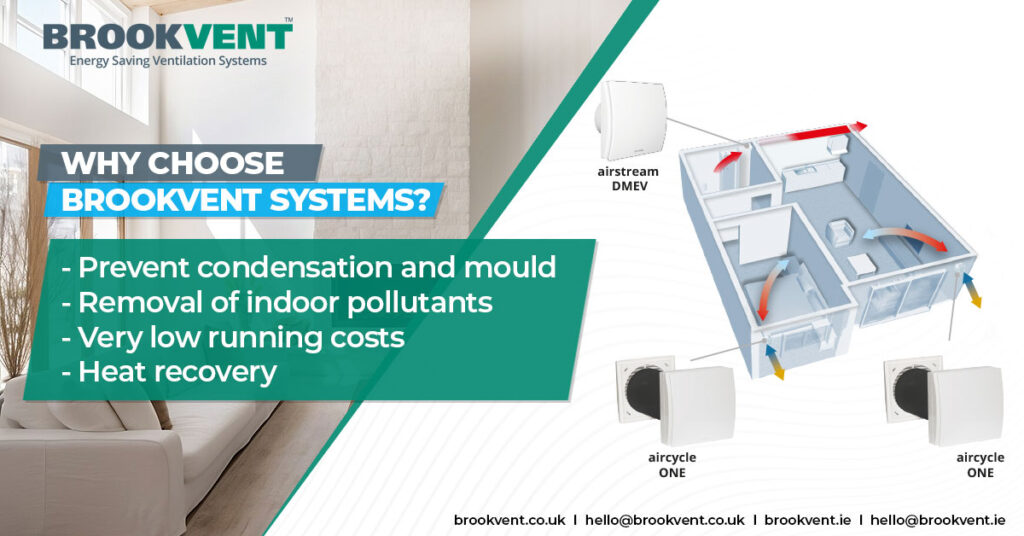

Choosing a Ventilation System for Your Home
Many homeowners today are experiencing problems related to poor ventilation in their homes. While ventilation issues can arise from various factors, poor airflow is a significant concern.
As heating costs continue to rise, finding alternative ways to retain warmth while ensuring fresh air circulation is becoming increasingly important, making Heat Recovery Ventilation (HRV) a valuable solution.
Identify the Right Ventilation System for Your Home
Choosing a ventilation system that meets the needs of your home is an important decision with so many different options available. However, by meeting the specific needs of your property you can get the best performance from your ventilation system.
Figuring out what your home needs starts with looking at things like the size of the property, or the size of the room. Older homes might need something to tackle dampness or poor airflow. Think about the climate where you live and any specific issues like allergies or high humidity. Speaking to a ventilation expert can make it easier to find the right solution to keep your home comfortable and your air fresh.
Understanding Different Types of Ventilation Systems
Each type of system offers specific benefits and features, making it an important decision and being well-informed. For instance:
- Heat Recovery Ventilation System: Provides healthier, cleaner air for inhabitants, Installing an MVHR system also combats issues arising from poor air quality. Airtight buildings with little ventilation often experience high condensation levels, mould, dust mites, and unpleasant smells.
- Single Room Heat Recovery: Offers all the benefits of heat recovery, with the added benefits of being suitable for retrofit applications and for single room usage rather than household-wide.
- Positive Input Ventilation (PIV): These units prevent and cure condensation and damp problems, and are also efficient at combatting other air pollutants – and even in reducing Radon gas levels.
With so many options available, it’s important to identify the specific issues in your property and choose a system that effectively addresses those needs.
Room-by-Room Guide for Choosing Ventilation Systems
Every room in your home has unique ventilation needs. For example, kitchens generate significant moisture and odours, making an effective system essential. A Decentralised Mechanical Extract Ventilation (DMEV) system is ideal in this space, as it detects humidity, drawing out moisture before it can lead to condensation or mould.
Bathrooms are another area that experiences high humidity from showers and baths, which can quickly lead to condensation and mould if not properly managed. DMEV systems are well-suited for bathrooms because they automatically control humidity levels.
Bedrooms/living rooms require consistent fresh air to help with mould due to heat and minimise allergens. Single-room Heat Recovery units are recommended as they will ensure the removal of indoor pollutants and prevent condensation and mould in your room, ensuring a healthier and more comfortable environment for all inhabitants.
- Basements and attics can be prone to dampness due to limited airflow. Positive Input Ventilation (PIV) systems introduce fresh air into a property through a central unit, dispersing it throughout the space. This process pushes out stale air and reduces humidity, making PIV a cost-effective solution for managing condensation issues in homes.
- Whole house systems: It can be more convenient for a Heat Recovery Ventilation System to be installed as this type of system works by continuously circulating air, ensuring every room benefits from improved air quality while also retaining heat, making it an efficient solution for maintaining comfort across the entire home.
- Natural Ventilation: through vents or trickle vents may suffice, although it won’t provide the same humidity control as mechanical systems.
Maintenance and Longevity of Ventilation Systems
Once you’ve selected a system, regular maintenance is essential to keep it operating efficiently and extend its lifespan. One key maintenance task is regular filter replacement. Clogged filters reduce system efficiency and can circulate pollutants back into the indoor air, so it’s essential to check and replace them regularly between 6-12 months.
Finally, schedule professional servicing annually to catch any potential issues early, ensuring a longer lifespan and better efficiency for the system.
The Value of Ventilation Specialists
Choosing and installing a system can be expensive, but consulting with a professional is often worth it to ensure you make the right choice. At Brookvent we are specialists and our team can help you assess your space and recommend the most effective and efficient system tailored to your needs. A well-installed ventilation system will provide consistent results and offer greater peace of mind.
Conclusion
Choosing the right system is essential for creating a healthy, comfortable, and energy-efficient environment. With the right system, you’ll not only enhance indoor air quality but also improve energy efficiency, providing a long-term solution for a healthier living or working environment. By following this guide, you can make an informed decision and enjoy the benefits of fresh, filtered air tailored to your needs.
Visit our website to explore our other range of products: Ventilation Systems | Energy Saving Ventilation | Brookvent
Contact our team on 02890616505, hello@brookvent.co.uk or Fill in our contact us form for more information!





